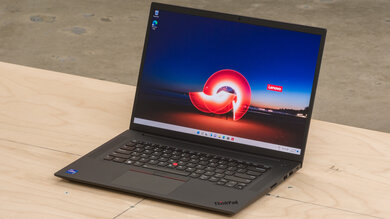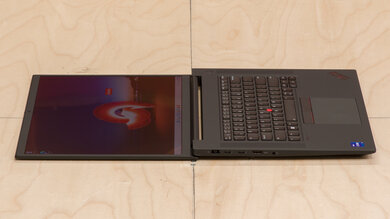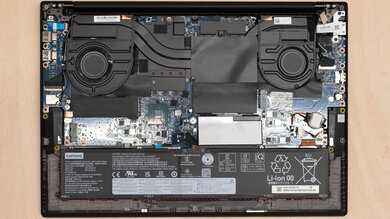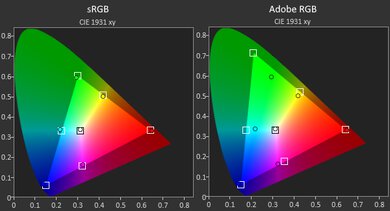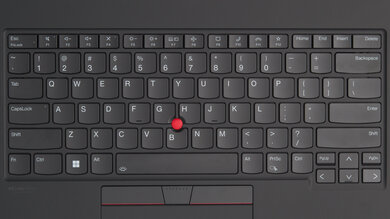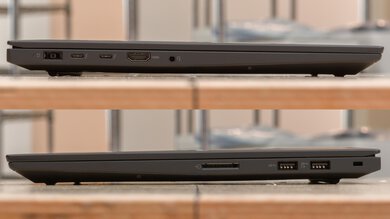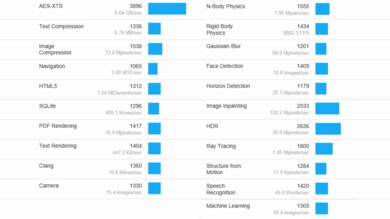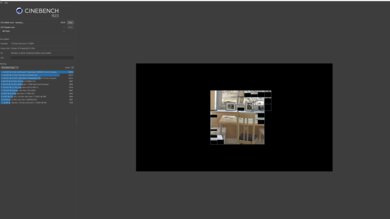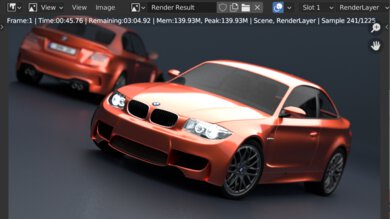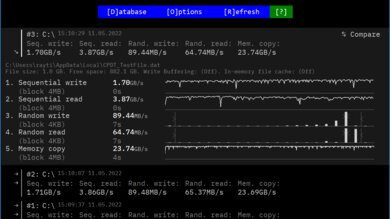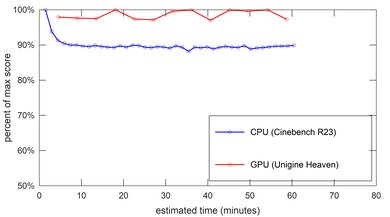The Lenovo ThinkPad P1 Gen 4 is a 16 inch mid-range mobile workstation. It replaces the Lenovo ThinkPad P1 Gen 3 from 2020 and competes with the likes of the Dell Precision 5560 (2021). This 4th Gen model looks very similar to its predecessor in design, but it now has a slightly larger 16 inch 16:10 display. Lenovo also upgraded the CPU from Intel 10th Gen to 11th Gen and added multiple new GPU options, from an NVIDIA T1200 to a GeForce RTX 3080. Other new features include Thunderbolt 4 and HDMI 2.1 support, PCIe Gen 4 x4 SSD options, and a 1080p webcam.
Our Lenovo ThinkPad P1 Gen 4 has an Intel Core i7-11800H CPU, an NVIDIA RTX A2000 discrete GPU, 32GB of memory, and 1TB of storage. You can upgrade the CPU to an Intel Core i7-11850H, i9-11950H, or Xeon W-11855M. Other GPU options include an NVIDIA T1200, RTX A3000, A4000, A5000, GeForce RTX 3070, and GeForce RTX 3080. You can get up to 64GB of memory and choose between non-ECC and ECC memory; however, the latter is only available on models with an Intel Xeon W-11855M CPU.
Our Verdict
The Lenovo ThinkPad P1 Gen 4 is decent for school use. It has a 16 inch display that provides plenty of space for multitasking, a keyboard that feels comfortable to type on for extended periods, and a touchpad that tracks well. It's a fairly thin and light laptop, so it isn't too cumbersome to carry around, although you'll have to bring the charger with you as the battery lasts a little less than 8 hours of light use. Its Intel 11th Gen CPUs and NVIDIA GPUs can handle demanding tasks, which is great for students in fields like graphic design, 3D animation, or engineering.
- Large, sharp, and bright display.
- Fairly easy to carry around.
- CPU and GPU can handle demanding workloads.
- Keyboard feels comfortable to type on for extended periods.
- Battery lasts less than 8 hours of light use.
- Webcam image looks too dark.
- Finish picks up fingerprints easily.
The Lenovo ThinkPad P1 Gen 4 is good for gaming. Its Intel 11th Gen CPUs and NVIDIA GPUs provide a smooth gaming experience at 1080p. You can even play at 1440p or 4k if you get a high-end GPU like the GeForce RTX 3070 and 3080. However, there are only 60Hz display options, and they all have a slow response time and no VRR support to reduce screen tearing. On the bright side, it has tons of ports for your peripherals, and its memory and storage are user-upgradeable. There's some thermal throttling on the CPU, but thankfully, none on the GPU.
- CPU and GPU can handle demanding workloads.
- Keyboard feels comfortable to type on for extended periods.
- User-upgradeable memory and storage.
- 60Hz display with slow response time and no VRR support.
- Slight CPU throttle.
- Finish picks up fingerprints easily.
The Lenovo ThinkPad P1 Gen 4 is decent for media consumption. It has a sharp, bright, and color-accurate QHD+ display, and there's also a 4k panel option if you want an even sharper image. The speakers sound full and well-balanced, and they get very loud with minimal compression. It isn't overly bulky or heavy, so it's still relatively easy to carry around; however, you'll need the charger as the battery lasts less than 4 hours of video playback. Unfortunately, it isn't the best for dark room viewing as its contrast isn't good enough to produce deep blacks.
- Large, sharp, and bright display.
- Fairly easy to carry around.
- Outstanding color accuracy out of the box.
- Speakers sound well-balanced and loud.
- Battery lasts less than 4 hours of video playback.
- Blacks look gray in dim settings.
- Finish picks up fingerprints easily.
The Lenovo ThinkPad P1 Gen 4 is excellent as a workstation. It's available with various Intel 11th Gen CPUs and NVIDIA discrete GPUs, which are powerful enough to handle demanding workloads. It has an outstanding port selection that includes USB-C/Thunderbolt 4 and HDMI 2.1 ports, a comfortable keyboard, and a fast PCIe Gen 4 SSD. There's some thermal throttling on the CPU under load, but luckily, none on the GPU. Its serviceability is outstanding as you can replace the memory, storage, wireless adapter, and battery.
- CPU and GPU can handle demanding workloads.
- 4k display option with 100% Adobe RGB coverage.
- Keyboard feels comfortable to type on for extended periods.
- Outstanding color accuracy out of the box.
- Wide port selection includes USB-C/Thunderbolt 4 and HDMI 2.1.
- User-upgradeable memory and storage.
- Slight CPU throttle.
- Finish picks up fingerprints easily.
The Lenovo ThinkPad P1 Gen 4 is good for business use. It feels decently well-built, and it's relatively portable as it isn't overly bulky or heavy. Its QHD+ display gets bright enough to combat glare and provides tons of room for split-screen multitasking, and you can upgrade to an even brighter 4k panel if you prefer. The keyboard feels great to type on, the touchpad tracks well, and there are tons of ports, including a full-size HDMI. Its Intel CPUs are powerful enough to handle general productivity tasks like web browsing, text formatting, spreadsheets, and presentations. It has a 1080p webcam, but it isn't very good as the captured image is too dark.
- Large, sharp, and bright display.
- Fairly easy to carry around.
- CPU and GPU can handle demanding workloads.
- Keyboard feels comfortable to type on for extended periods.
- Wide port selection includes USB-C/Thunderbolt 4 and HDMI 2.1.
- Battery lasts less than 8 hours of light use.
- Webcam image looks too dark.
- Finish picks up fingerprints easily.
Changelog
- Updated Sep 16, 2022: Added mention of the Dell Precision 5570 (2022) as an alternative with a better touchpad.
- Updated Sep 07, 2022: Added mention of the HP ZBook Firefly 15 G8 (2021) as an alternative with longer battery life.
- Updated Aug 22, 2022: Added mention of the Dell Precision 3571 (2022) as an alternative with newer Intel 12th Gen CPUs.
- Updated Aug 08, 2022: Added mention of the Lenovo ThinkPad P15 Gen 2 (2021) as an alternative with better performing GPUs.
Check Price
Differences Between Sizes And Variants
We tested the Lenovo ThinkPad P1 Gen 4 (model 20Y3008BUS) with a QHD+ display, an Intel Core i7-11800H CPU, an NVIDIA RTX A2000 discrete GPU, 32GB of non-ECC memory, and 1TB of storage. The screen, CPU, GPU, memory, and storage are configurable; you can see the available options in the table below. Our review applies only to variants with a model number starting with '20Y3'.
| Screen |
|
|---|---|
| CPU |
|
| GPU |
|
| Memory |
Non-ECC memory:
ECC memory:
|
| Storage |
|
| Color |
|
Our display and performance results are only valid for the configuration we tested. If you come across a different configuration option not listed above, or you have a similar Lenovo ThinkPad P1 that doesn't correspond to our review, let us know, and we'll update it. Some tests, like black uniformity and color accuracy, may vary between individual units.
You can see our unit's label here.
Popular Laptop Comparisons
The Lenovo P1 Gen 4 is an excellent workstation that provides good performance in a relatively thin and light chassis. Its build doesn't feel as sturdy compared to a similar mobile workstation like the Dell Precision 5560 (2021), but it has more ports and is available with more powerful GPUs.
For more options, see our recommendations for the best laptops or all of our laptop reviews.
The Lenovo ThinkPad P1 Gen 4 (2021) and the Dell Precision 5560 (2021) are both thin and light Windows mobile workstations with Intel 11th Gen CPUs and NVIDIA discrete GPUs. The Dell is slightly more compact, making it easier to carry around, and its build feels sturdier. It also has a much better touchpad and longer battery life. On the other hand, the Lenovo has more ports and doesn't get as hot as the Dell under load. Performance is very similar between them with the same configuration; however, the Lenovo offers more powerful GPU options, up to an NVIDIA RTX A5000 and GeForce RTX 3080.
Although the Lenovo ThinkPad P1 Gen 4 (2021) and the Apple MacBook Pro 14 (M1, 2021) are both mobile workstations, there are a lot of differences between them. The ThinkPad is a 16 inch Windows laptop, while the MacBook Pro is a 14 inch macOS laptop. The MacBook Pro has a sturdier build, a much better touchpad and webcam, longer battery life, and doesn't get as hot or loud under load. It also has a 120Hz Mini LED display that produces deeper blacks and provides better responsiveness. The MacBook Pro's M1 SoCs perform better than the ThinkPad's Intel 11th Gen processors, but the ThinkPad has higher-end GPU options that provide better graphical performance. The ThinkPad has more ports, and its memory and storage are user-upgradeable, which you can't do on the MacBook Pro.
The Lenovo ThinkPad P15 Gen 2 (2021) and the Lenovo ThinkPad P1 Gen 4 (2021) are both mobile workstations with fairly similar features and CPU/GPU configurations. The main difference is that the P1 Gen 4 has a thinner and lighter design for portability, whereas the P15 Gen 2 is a much bulkier device with a more robust cooling system to allow the GPU to run at a higher wattage, resulting in better performance.
The Lenovo ThinkPad P1 Gen 7 (2024) is a newer version of the Lenovo ThinkPad P1 Gen 4 (2021) and a much better device overall. The Gen 7 is available with more powerful CPUs and GPUs, and there are better display options as well, including a 165Hz QHD+ IPS and a 4k+ OLED panel. It also has a sturdier build, a larger and more responsive haptic touchpad, a higher quality 1440p webcam, and a significantly longer battery life.
Test Results

The Lenovo ThinkPad P1 Gen 4 has a simple and understated design that fits well in any office setting. It has an all-black chassis with thin bezels, speakers on both sides of the keyboard, and vents on the bottom and back. The TrackPoint nub at the center of the keyboard lets you move the mouse cursor, which some people might find more convenient than using the touchpad. There are additional mouse buttons at the top of the touchpad so that you don't have to move your hand to the touchpad to click when using the TrackPoint. The laptop is only available in black, but models with a 4k display have a weaved carbon fiber lid, whereas the QHD+ models are just plain black.
The Lenovo ThinkPad P1's build quality is decent. The bottom is aluminum, and the top is carbon-fiber-reinforced plastic. There's some flex in the display and keyboard deck; however, the device as a whole feels relatively solid. Its soft-touch finish is fairly scratch-resistant, but it picks up fingerprints easily.
The Lenovo P1 Gen 4 has an outstanding hinge. It feels smooth when opening and closing the lid, and it's very stable, exhibiting almost no wobble at all. Although there's a lot of resistance in the hinge, you can still open the laptop with one hand, which is a nice quality-of-life feature that makes the device feel more premium.
The Lenovo ThinkPad P1 is decently portable. It isn't as thin and light as an ultraportable laptop like the Dell XPS 13 (2021), though it isn't particularly bulky or heavy and should fit into most bags. The 170W power adapter is on the larger side but still relatively light.
The size and weight of the 135W and 230W power adapters are different; the 135W power adapter has a volume of 12.2 in³ (200cm³) and weighs 0.82 lbs (370g), while the 230W has a volume of 21.6 in³ (354cm³) and weighs 1.8lbs (815g).
The Lenovo P1's serviceability is outstanding. It's very easy to access the internals; you only have to remove seven Philips screws and undo the clips holding the bottom panel with a pick or prying tool. The screws don't come off completely because they're captive screws, so you don't have to worry about losing them. Once inside, you can replace the memory, storage, wireless adapter, and battery. Only models with an NVIDIA T1200 or RTX A2000 GPU have two storage slots; all other models have one. Opening the laptop and changing the hardware may void the manufacturer's warranty.
The Lenovo ThinkPad P1 is available with the following displays:
- 16 inch IPS 2560 x 1600 60Hz (matte)
- 16 inch IPS 3840 x 2400 60Hz (matte)
- 16 inch IPS 3840 x 2400 60Hz (glossy, touchscreen)
The QHD+ display looks sharp and provides enough space for split-screen multitasking. Its 16:10 aspect ratio gives you slightly more vertical room than a standard 16:9 display so that you don't have to scroll as much when reading a document or website. The 4k displays are sharper (283 PPI); however, the difference is hard to notice at typical viewing distances, and the increased resolution will shorten the battery life significantly. That said, it's still worth upgrading to a 4k display if you're a content creator or perform color-critical work because they have a wider color gamut.
There are online reports of graphical issues causing black and white stripes throughout the screen when waking the laptop from standby mode; however, we didn't experience it while testing.
The Lenovo P1 Gen 4's QHD+ display has a basic 60Hz refresh rate. It also has a slow response time, causing noticeable ghosting in fast-moving content, and it doesn't support variable refresh rate to reduce screen tearing when gaming. The 4k displays will perform similarly.
The Lenovo P1's QHD+ display has a good contrast ratio for an IPS panel, slightly better than the advertised 1200:1 contrast. However, blacks still look gray in dim settings. If you want a display that can produce deeper blacks, it's best to get a laptop with an OLED or Mini LED panel, like the Apple MacBook Pro 14 and 16 (2021). The 4k displays have a slightly higher advertised contrast of 1500:1, which is only a small increase and not enough to make much difference. The contrast ratio can vary between individual units, but the difference is usually minor and isn't noticeable.
The Lenovo P1's QHD+ display gets bright enough for use in most settings. It's just enough for use outdoors in broad daylight when viewing light-color content, but dark content is harder to see. It gets very dim at the lowest brightness setting to provide a more comfortable dark room viewing experience. The 4k displays have an advertised brightness of 600 cd/m², which is more than enough for outdoor use.
The Lenovo P1 Gen 4 has decent reflection handling. Its matte anti-reflective coating does a good job of diffusing and reducing the intensity of direct reflections, like a lamp or open window during the day. However, bright lights cause a hazy look throughout the screen. It isn't a problem when viewing light-color content with the screen at maximum brightness, but it makes dark content harder to see. The 4k touchscreen has a glossy finish that'll perform better against indirect reflections, but you'll get more direct, mirror-like reflections.
The Lenovo P1's black uniformity is great. It's slightly patchy, and there's a little bit of backlight bleed at the bottom edge. However, these issues are relatively minor and hard to notice, even when displaying dark content in a dim setting. Black uniformity varies between individual units due to manufacturing tolerances; you may get some backlight bleed, which is common for IPS panels, but you can expect the rest of the screen to be fairly similar.
The Lenovo ThinkPad P1 has mediocre horizontal viewing angles. The image dims and washes out quickly as you move to the side. You have to be more or less directly in front of the screen to see an accurate image. The 4k display will likely perform similarly.
The Lenovo P1 has sub-par vertical viewing angles. You have to look at the screen directly to see an accurate image, which might be a problem in tight places where you don't have much room to tilt the screen to your liking, like on an airplane.
The Lenovo P1 Gen 4 has outstanding color accuracy out of the box. Aside from pure blue, most color inaccuracies are minor and hard to notice. The white balance is excellent, and the color temperature is just slightly cooler than the standard 6500k target, giving the image a barely noticeable blue tint. The gamma stays relatively flat instead of following the sRGB curve, making dark scenes too dark and bright scenes too bright. Color accuracy varies between individual units, but the difference is usually minimal.
The Lenovo P1 Gen 4's QHD+ display has a very good color gamut. It has near full coverage of the commonly-used sRGB color space; it's just missing some blues and greens. It has good Adobe RGB and DCI P3 coverage, but it isn't enough for professional-level colorwork. If you need to edit photos and videos or perform any work that requires color accuracy, it's best to go with the 4k+ displays as they have an advertised 100% Adobe RGB coverage. The 4k displays also have 10-bit color depth (8-bit + FRC), DisplayHDR 400 certification, and Dolby Vision HDR support.
The Lenovo ThinkPad P1 Gen 4 has a great keyboard. It feels spacious, with a layout that's easy to get used to. The keys are stable, have a good amount of travel, and provide satisfying tactile feedback. They require a fair amount of force to get over the tactile bump, but the overall typing experience still feels light and doesn't cause fatigue over an extended period. You can toggle between two backlight brightness levels or turn it off completely.
The Lenovo P1 Gen 4's touchpad is decent. It's reasonably large and feels smooth, with no wobble whatsoever. It tracks movements and gestures well, and there aren't any palm rejection issues, although dragging and dropping doesn't always work properly. You can click on the bottom half of the touchpad or use the dedicated buttons at the top. The touchpad's click mechanism doesn't feel particularly satisfying, but the dedicated buttons do. Lenovo's Trackpoint nub at the center of the keyboard gives you an alternate way of controlling the mouse cursor, which some people might find more efficient as you don't have to move your hand as much. The Trackpoint is pressure-sensitive, meaning the cursor will move faster if you press harder in any given direction; however, that makes it finicky to control as it's hard to maintain a consistent level of pressure. If you want a mobile workstation with a better touchpad, check out the Dell Precision 5570 (2022).
The Lenovo P1 has outstanding speakers. They fire upward from both sides of the keyboard and get very loud with minimal dynamic compression at max volume. They sound full and well-balanced, with a hint of bass, though they can be a little boxy in some content.
The Lenovo ThinkPad P1's webcam video quality is sub-par. Although it captures a fair amount of detail, the whole image is too dark. The microphone sounds quiet and makes voices sound nasal and robotic; however, it does a good job suppressing background noise. The privacy cover disables the camera at the software level but not the microphone. If you want a mobile workstation with a better webcam, check out the ASUS ProArt Studiobook Pro 16 OLED (2021).
The Lenovo P1 Gen 4 has an outstanding port selection. The two USB-A ports support USB 3.2 Gen 1 data transfer speed (up to 5Gbps). The USB-A closest to the back is always on, meaning you can use it to charge another device even when the laptop is in sleep mode. The two USB-Cs support Thunderbolt 4 (up to 40Gbps data transfer speed and two 4k displays at 60Hz) and DisplayPort 1.4. You can charge the laptop via USB-C, but it doesn't work with all chargers, and it won't charge as fast as the included power adapter because the USB-C port can only accept a maximum of 100W. Models with an NVIDIA T1200 GPU have an HDMI 2.0 port instead of HDMI 2.1. There's a slot on the right side for a Kensington NanoSaver security lock.
The Lenovo ThinkPad P1 Gen 4 has an Intel AX210 wireless adapter. Models with WWAN support also have a Qualcomm Snapdragon X55 5G CAT20 adapter (models with an NVIDIA T1200 and RTX A2000 only). Models with an NVIDIA RTX A3000, A4000, A5000, GeForce RTX 3070, or GeForce RTX 3080 GPU don't support WWAN.
The Lenovo ThinkPad P1 Gen 4 is available with the following CPUs:
- Intel Core i7-11800H (8 cores/16 threads, up to 4.6GHz, 24MB cache)
- Intel Core i7-11850H (8 cores/16 threads, up to 4.8GHz, 24MB cache)
- Intel Core i9-11950H (8 cores/16 threads, up to 5.0GHz, 24MB cache)
- Intel Xeon W-11855M (6 cores/12 threads, up to 4.9GHz, 18MB cache)
The Core i7s and i9 are high-power mobile CPUs typically found in gaming laptops and workstations, capable of handling demanding tasks like CAD, animation, and photo/video editing. The i7-11850H and i9-11950H have the same number of cores as the base i7-11800H, but they have faster clock speeds, giving them a slight performance boost. The Xeon W-11855M has fewer cores and threads, which will result in worse multi-thread performance, but unlike the Core CPUs, it supports ECC (Error Code Correction) RAM. If you want a mobile workstation with newer Intel 12th Gen CPUs, check out the Dell Precision 3571 (2022).
You can configure the Lenovo ThinkPad P1 Gen 4 with the following GPUs:
- NVIDIA T1200 4GB GDDR6 (35W TGP)
- NVIDIA RTX A2000 4GB GDDR6 (35W TGP)
- NVIDIA RTX A3000 6GB GDDR6 (80W TGP)
- NVIDIA RTX A4000 8GB GDDR6 (80W TGP)
- NVIDIA RTX A5000 16GB GDDR6 (80W TGP)
- NVIDIA GeForce RTX 3070 8GB GDDR6 (80W TGP)
- NVIDIA GeForce RTX 3080 16GB GDDR6 (80W TGP)
The NVIDIA T1200, RTX A2000, A3000, A4000, and A5000 are professional laptop GPUs designed for demanding production workloads like graphic design and 3D modeling, while the GeForce RTX 3070 and 3080 are more mainstream laptop gaming GPUs. For context, the T1200's performance is roughly equivalent to an NVIDIA GeForce GTX 1650/1650Ti, the RTX A2000 is equivalent to an RTX 3050/3050Ti, and the A3000 is equivalent to an RTX 3060. The A4000 and A5000 have the same number of CUDA cores, ray-tracing cores, AI Tensor cores, and memory as the RTX 3070 and 3080, respectively. However, they differ in other features like the memory bandwidth and shader model. You can see the differences between all the available GPUs in Lenovo's specifications. Generally speaking, more cores will result in better performance and a smoother experience overall. All the GPUs are suitable for gaming, but it's best to get a model with an NVIDIA GeForce RTX 3070 or 3080, as they'll have better, more optimized drivers. If you want a similar mobile workstation with better performing GPUs (Total Graphics Power), check out the Lenovo ThinkPad P15 Gen 2 (2021).
You can configure the Lenovo ThinkPad P1 Gen 4 with 8, 16, 32, or 64GB of memory. You can choose between non-ECC or ECC (Error Code Correction) modules; however, ECC RAM is only available on models with an Intel Xeon W-11855M CPU. ECC RAM is a type of memory typically used in workstations and servers. It checks and corrects any data corruption to provide better system stability. Some models only have a single memory module running in single-channel mode, so if you don't plan on adding a second module yourself, it's best to get a model with dual-channel memory. You can check each model's configuration here.
You can configure the Lenovo ThinkPad P1 Gen 4 with 256GB, 512GB, 1TB, or 2TB of storage. Models with an NVIDIA T1200 or RTX A2000 GPU have two storage slots, giving you the option to add a second SSD.
The Lenovo P1 has an outstanding overall score in Geekbench 5, performing well in both the single and multi-thread CPU tests. It isn't as good as Apple's M1 Pro SoC or even Intel's own 12th Gen processors, like the Dell G15 (2022)'s Core i5-12500H, but it's good enough for demanding production workloads. The Intel Xeon W-11855M will perform worse in multi-threaded applications because it has fewer cores and threads, while the Intel Core i7-11850H and the i9-11950H will be slightly faster overall.
The NVIDIA RTX A2000 is excellent for GPU compute tasks. It scores roughly the same as an NVIDIA GeForce RTX 3050, a lower mid-range gaming GPU. Every GPU configuration can handle intensive GPU compute tasks, so choosing between them depends on the type of work you do and the complexity of the material. A faster GPU will allow you to complete renders faster and provide a smoother experience.
The Intel Core i7-11800H in the Lenovo ThinkPad P1 Gen 4 performs exceptionally well in Cinebench R23, almost identical to the one in the Dell Precision 5560 (2021). It's a little worse than expected due to thermal throttling, but it's still suitable for professional-level rendering. The Intel Core i7-11850H and Intel Core i9-11950H will only be slightly faster; however, the Intel Xeon W-11855M will be slower because it has fewer cores.
The Lenovo P1 Gen 4's performance in Blender is excellent. Although all the CPUs can do a good job, it's always faster to use the dedicated GPU, especially when using NVIDIA Optix hardware acceleration. The NVIDIA T1200 will be slightly slower, but all other GPU configurations will be faster.
The Lenovo P1 Gen 4 with an NVIDIA RTX A2000 performs well in the Basemark GPU benchmark, scoring roughly the same as the NVIDIA GeForce RTX 3050 in the Lenovo IdeaPad Gaming 3 (2021).
At 1080p, the NVIDIA RTX A2000 can push around 60fps in graphically demanding games with high settings. The NVIDIA T1200 can also reach 60fps in most games, but you'll have to turn down some settings to get there, while the NVIDIA A3000 can push slightly higher frame rates than the A2000. The NVIDIA A4000 and GeForce RTX 3070 will allow you to play most games at 1440p, while the RTX A5000 and GeForce RTX 3080 will allow you to play at 4k.
The Lenovo ThinkPad P1's storage drive performance is outstanding. Its PCIe Gen 4 x4 NVMe SSD has exceptionally fast read and write speeds, allowing the system to boot up, launch apps, and transfer files quickly. Some models come with a slower PCIe Gen 3 x4 SSD, and the SSD's speed may vary depending on the size, as larger SSDs tend to perform better.
The Lenovo P1 Gen 4 has mediocre battery life. Since this is a workstation designed for demanding tasks, you can expect the battery life to be similar to when gaming, which means you'll have to use it plugged in most of the time. The system switches between the CPU's integrated GPU and the dedicated NVIDIA GPU to give you longer battery life in lighter workloads, but you'll still have to plug it in for a quick charge to get through a typical 8-hour workday. If you want a mobile workstation with longer battery life, check out the HP ZBook Firefly 15 G8 (2021). Battery life varies greatly depending on your usage and the laptop's configuration.
Borderlands 3 is very choppy at high settings on the Lenovo ThinkPad P1 Gen 4 with an Intel Core i7-11800H and NVIDIA RTX A2000. The average frame rate is decent, but it stutters a lot. It's a lot better at low settings, but you'll still experience some choppiness here and there. The NVIDIA T1200 can reach 60fps, but only with low settings, similar to the Dell Precision 5560 (2021). The NVIDIA A3000, A4000, A5000, GeForce RTX 3070, and GeForce RTX 3080 can run this game without any issue. You can even play at 1440p or 4k with the RTX 3070 and 3080.
Civilization VI runs well on the Lenovo ThinkPad P1. The average frame rate at high settings is great, and there are barely noticeable and only occasional frame drops. Every GPU configuration can run this game smoothly; however, you'll have to turn down some settings to get to 60fps with an NVIDIA T1200. The average turn time is decent and within the expected range. Upgrading the CPU to the Intel Core i7-11850H or i9-11950H will only improve the turn time slightly, not enough to make much difference.
The Lenovo P1 Gen 4 performs exceptionally well in CS:GO. The Intel i7-11800H and NVIDIA RTX A2000 configuration push out very high frame rates for smooth gameplay, with only occasional stutters. Every CPU and GPU configuration can run this game smoothly without any issues.
Shadow of the Tomb Raider runs reasonably well on the Lenovo P1 with an Intel i7-11800H CPU and NVIDIA RTX A2000 GPU. The average frame rate at 1080p with high settings is good, and although the frame rate drops below 30fps at times, it doesn't happen often.
The NVIDIA T1200 will perform worse and in the same ballpark as the Dell Precision 5560 (2021), meaning you'll have to turn down some settings to get to 60fps. The other GPU configurations will perform better and provide smoother gameplay. The A4000, A5000, RTX 3070, and RTX 3080 can also run this game at 1440p or even at 4k with low settings. The large frame time spikes are scene changes and aren't representative of the laptop's performance.
The Lenovo P1 Gen 4 has adequate thermal and noise handling. In an idle state, the keyboard is a little warm but by no means uncomfortable, and the fans are completely silent. The keyboard gets much hotter under load, but it isn't much of an issue as the deck where most people rest their hands is still cool. The fans ramp up quickly when performing demanding tasks and are audible; however, they don't get annoyingly loud.
The Lenovo P1's performance over time is great. The GPU remains relatively cool under load and doesn't throttle at all. However, the CPU gets very hot and throttles quickly, causing slight performance loss. The performance drop isn't significant but still noticeable. Models with an NVIDIA RTX A3000, A4000, A5000, GeForce RTX 3070, or RTX 3080 GPU will perform differently, as they have a cooling system with a vapor chamber.
The Lenovo P1 has a few pre-installed applications, including:
- Disney+: App for the video streaming service.
- Dolby Access: Adds Dolby Atmos support and allows you to change the speakers' sound profile.
- Glance by Mirametrix: Software application that adds attention sensing capability. When enabled, it can automatically lock your computer when you walk away, pause a video or blur the content when you aren't directly looking at the screen, or move windows from one screen to another.
- Lenovo Commercial Vantage: Lets you view system status, change various settings, and give access to IT admins to troubleshoot and fix issues.
- Lenovo Quick Clean: Lets you lock the keyboard and touchpad for cleaning.
Depending on the manufacturing date, you may get Windows 10 or Windows 11 preloaded. There are also models with Ubuntu 64-bit (Version 20.04 LTS, running the 4.15.0-1039-OEM kernel) or no operating system. The ThinkPad P1 Gen 4 has certifications from Independent Software Vendors (ISVs) to ensure that professional applications run reliably; you can see the list of certified applications here.
The Lenovo P1 has a fingerprint sensor built into the power button and a Windows Hello compatible hybrid 1080p IR camera for facial recognition, allowing you to log in quickly, authorize purchases on the Windows Store, and auto-fill saved passwords on supported websites. The hybrid camera is an optional feature, meaning it's only on select models. The 4k touchscreen display supports pen input. It uses Wacom AES pen technology with 4096 levels of pressure sensitivity and tilt support. The stylus is an accessory that you buy separately, but some bundles include one.

